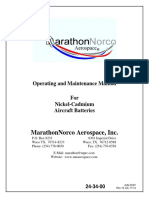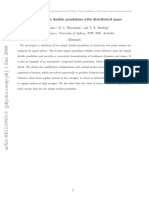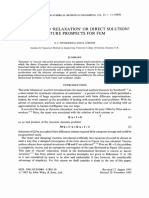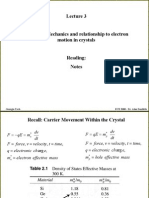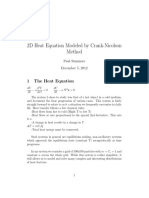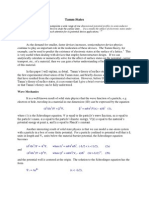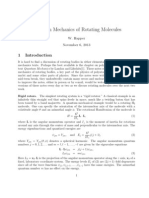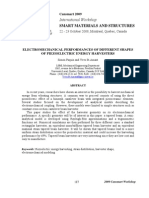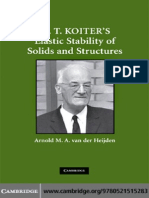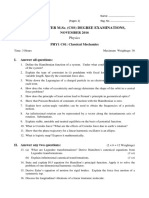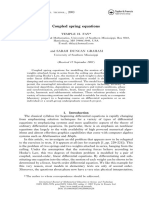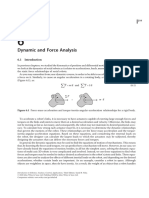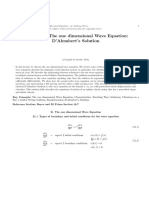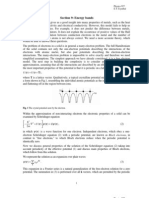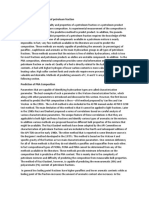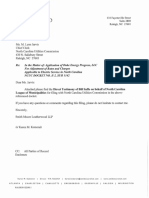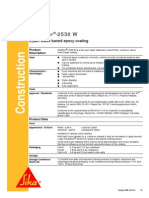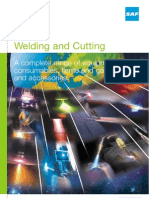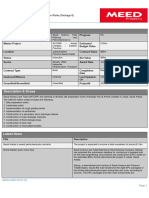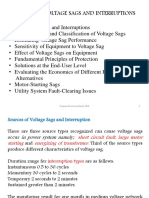Resonance Science
Resonance Science
Uploaded by
pawan_aggarwal_22Copyright:
Available Formats
Resonance Science
Resonance Science
Uploaded by
pawan_aggarwal_22Original Title
Copyright
Available Formats
Share this document
Did you find this document useful?
Is this content inappropriate?
Copyright:
Available Formats
Resonance Science
Resonance Science
Uploaded by
pawan_aggarwal_22Copyright:
Available Formats
Classroom
In this section of Resonance, we invite readers to pose questions likely to be raised in a classroom situation. We may suggest strategies for dealing with them, or invite responses, or both. Classroom is equally a forum for raising broader issues and sharing personal experiences and viewpoints on matters related to teaching and learning science. Getting Acquainted with Gears and Wheels Quantum Mechanically
Kamal Sharma and N Kumar Raman Research Institute Bangalore 560 080, India. Email: nkumar@rri.res.in
For a pair of wheels or gears with positive coupling, i.e., without slip or play, there are rules of engagement that have some interesting consequences when their dynamics is treated quantum mechanically. We will illustrate the principal ideas involved here with the help of an elementary, basically a textbook exercise whose solution, however, is not only interesting, but may also be re-interpreted rather creatively. Possible relevance of this simple exercise to the incredible, ever-shrinking world of the nano (1 nm = 109 m) is pointed out. 1. Introduction and Motivation The invention of the wheel has been considered by many to be one of the oldest and the greatest inventions of mankind, dating back to ca.1000 BC. The same may more are less, be said of the gear (Figure 1) { after all, the toothless wheel is an analog of the digital toothed gear. For a mathematically minded number theorist, however, we hasten to add that the gear has a countable discrete-
Keywords Nano-gears, no-slip condition, constraint, quantum mechanics.
RESONANCE January 2013
67
CLASSROOM
Figure 1. Two gears engaged so as to transmit motion.
ness, i.e., its teeth can be counted, whereas the wheel is an uncountable continuum. The twain have dierent cardinality! In the following, however, we will continue to use the two terms interchangeably. After all, for any wheel one can always nd a gear approximant to the desired order of precision/resolution. Some of these issues will recur in the course of our discussion. Over the millennia, natural philosophers (physicists and mathematicians) and engineers alike have engaged with the gear/wheel and the complex mechanisms based on these. In fact, Aristotle (ca. 300 BC) had suggested the use of the frictionally engaged wheels to transmit motion. Some of the other great names that readily come to the mind are Archimedes (ca. 250 BC) for his association with the design of the antikythera { a geared mechanical computer of great complexity; Galileo (ca. 1600 AD) for the Galilean Jovilabe with the surprising non-reversibly geared clock mechanism; and so on until we nally come to James Clerk Maxwell (1837{ 1879), who created a truly powerful mental construct, a mechanical model for the electromagnetic phenomena { with tiny spinning cells, idler wheels, and roller contacts without slip, lling the space [1]. We have, of course, come a long way { from the potter's crude wooden wheels to the nely geared watches and the robust power machines { and we see gears at every turn of an engine. But, no matter how sophisticated and varied are our gears today as compared to the potter's ancient wheels, they all share a basic commonality { they are all governed by classical mechanics (Newton's Laws of Motion). But, this may have to change now as we continually downsize our devices to the nano/subnanoscales; and still there seems to be plenty of room left at the bottom [2]. A question one may reasonably ask now is whether these enmeshed nano-gears will behave essentially in the same manner as the gears we are familiar with. Well, the answer is a denite NO!
68
RESONANCE January 2013
CLASSROOM
Figure 2. Two engaged wheels without slip; analog version of the enmeshed digital gear.
The domain of the nano/sub-nanoscale is ruled by the quantum. There may be surprises and even some creative re-interpretations possible. We must, therefore, get re-acquainted with the gear and the wheel { but now quantum-mechanically! And we will do this here through a study of the simplest of examples, viz., a pair of coupled circular discs lying in a plane. Consider a system of two co-planar discs 1 and 2 of radii a1 and a2, free to rotate about their respective centres c1 and c2 xed in the plane, and enmeshed such that there is no slip at the point of their contact P as shown in Figure 2. This schematic depicts our elementary model system of two wheels/gears properly engaged. A classical treatment of this two-body dynamical system begins with the Lagrangian, L = K U for the system, where K is its total kinetic energy expressed _1 and _2 , and U is in terms of the (angular) velocities the total potential energy as a function of the (angular) coordinates 1 and 2 . Inasmuch as there is no energy term depending on the (angular) coordinates 1 and 2, the total potential energy U = 0. Now, the total kinetic energy (K ) of the coupled system is given by 1 _ 2 1 _2 K = I1 + I2 2 1 2 2 (1)
RESONANCE January 2013
69
CLASSROOM
1 2 with I1(= 1 M1 a2 1 ) and I2 (= 2 M2 a2 ) being the moments 2 of inertia of the two circular discs of mass M1 and M2 respectively. Here the overhead dot denotes time derivative.
Next, we turn to the no-slip constraint. This may be implemented through the condition _1 = a2 _2 : a1 (2)
The classical dynamics is, therefore, completely determined by the total kinetic energy K and the no-slip constraint, as in (1) and (2) respectively. (A classical dynamical system with constraints involves, in general, somewhat advanced methods of classical mechanics [3]. Further, the presence of any angle-dependent potential would have made the no-slip condition non-trivial to implement). In the present case, however, we can simply rewrite the constraint in equation (2) as, _2 = a1 _1 ; (3) a2 _2 , say, in favour of _1 throughout. and thus eliminate _1 in favour of (Clearly, we could equally well eliminate _2, and then repeat the same treatment as given below. We will obtain the same nal results. The reader is encouraged to verify this explicitly). We can now express _1 , the kinetic energy K given in (1) as a function of alone: " 2 # 1 a1 1 _2 2 _1 K= I1 + I2 I (4) 2 a2 2 1 with I an eective moment of inertia. Thus, the no-slip constraint in (2) has eectively reduced the number of degrees of freedom by one (without changing the physics, of course). For the sake of clarity, let us rename this remaining degree of freedom as ( 1 ). Since, as noted above, there is no potential energy term in this problem, the kinetic energy K expressed entirely in terms
70
RESONANCE January 2013
CLASSROOM
_ 1 ( _ ) is nothing but the total of the angular velocity Lagrangian L for the system. Next, we go from the Lagrangian (L) to the Hamiltonian (H ) which is convenient for treating the problem quantum mechanically. For this, we have to introduce the canonical (angular) momentum J conjugate to the (angular) coordinate as J= @L _ = I : _ @ (5)
The classical Hamiltonian H is then given by the Legen_ L, and expressing the latdre transformation H = J ter in terms of the canonical momentum J using (5). We at once obtain [3] H= J2 : 2I (6)
This essentially completes the classical Hamiltonian formulation of the 2-disc problem with the no-slip constraint built in. It is to be noted that equation (6), together with (5), describes eectively a single -disc problem, with the eective disc moment of inertia = I . This is classically exact in and of itself. Here J is the constant of motion related to the conserved energy (= J 2 =2I ) of the system. We would like to re-emphasize here that in a classical mechanical treatment, the two-disc problem with no-slip condition is mathematically completely equivalent to a one-disc problem; i.e., from their classical dynamical (Newtonian) equations of motion, one cannot tell the two apart. As will be shown below, this, however, is not the case quantum-mechanically, and the physics becomes rather subtle. Let us, therefore, turn now to a quantum treatment of the same two-disc problem. Note rst that in the classical case as treated above, the existence of the other disc (disc 2) is, of course, implicit { but it enters only parametrically in the eective one-disc Hamiltonian as
RESONANCE January 2013
71
CLASSROOM
a modied moment of inertia (equation (6)). In the quantum-mechanical treatment too, the Hamiltonian formally appears as in the one-disc problem, but the mere existence of the (now hidden ) other disc in the original two-disc problem brings about certain global changes in the allowed solutions that have observable consequences quantitatively as well as qualitatively. Let us see how this comes about. In the quantum case, the classical Hamiltonian H and the angular momentum J as derived above are to be ^ and J ^), with treated as operators (H ^2 ^ =J ; H 2I and ^ = i ~ @ ; J @ (7)
whose eigenvalues give the simultaneously allowed energy and the angular momentum for the 2-disc dynami^ and J ^ are Hermitian operators cal system. (Note that H with real eigenvalues, and they commute). All we have to do now is to solve the associated eigenvalue equation (the time-independent Schr odinger equation) ~2 @ 2 () ^ H () = E(); 2I @2 (8)
where we have explicitly indicated the (angular) coordinate as the argument of the wavefunction (). (Recall that 1 ). The solution is readily seen to be () / eik with Ek = ~2 k 2 2I (the energy eigenvalue); (9b) (to within a normalization) (9a)
where the parameter k is to be determined from the boundary condition for the problem as follows. Formally, (9) may well describe a one-disc problem with an eective moment of inertia I1 + I2 (a1=a2 )2 . For
72 RESONANCE January 2013
CLASSROOM
such a one-disc problem, the single-valuedness of the wavefunction would demand a periodic boundary condition with period 2, i.e., () = ( + 2) inasmuch as for the single disc, the angles and + 2 refer to identical single-disc congurations (i.e., a complete cycle, or a 2 -turn restores the disc to status quo ante !). The periodic boundary condition eik2 = 1 then forces k to be an integer (= N , say) giving the allowed en2 2 ergy eigenvalues as EN = ~ 2N . This result is, however, I not valid in the quantum two-disc case inasmuch as the two enmeshed sub-systems, namely the two discs, must be treated as a single whole system with a global wavefunction. The uniqueness of this global wavefunction, therefore, demands that any two congurations of the two-disc system be now identied as being the same if they dier by integral numbers (n1 and n2 , say) of complete turns of the two component discs 1 and 2. This leads to a novel strictly quantum mechanical feature, as discussed below. The no-slip condition now constrains j n1a1 j=j n2a2 j with a1 a2, say, without loss of generality. Clearly, this can be satised if and only if the wheel ratio a1=a2 = a rational number. (This is quite analogous to the problem of periodic occurrences (syzygy ) of straight-line alignment of planets in our solar system, the period being essentially the lowest common multiplier (LCM) of the planetary periods). Thus, in our case, for example, if a1 =a2 = 4=6 2=3, then 3 turns of disc 1 will correspond to 2 turns of disc 2. So, for this case, the single-valuedness of the global wavefunction requires 2 N2 k 3 2 = N 2 , or k = N=3, giving EN = ~ 2I 9 as the allowed energy eigenvalues, where the energy-level index N is an integer. For the general case of rational wheel ratio, therefore, the energy eigenvalues EN turn out to be given by EN = ~2 N 2 ; 2In2 1 (10)
RESONANCE January 2013
73
CLASSROOM
where the wheel ratio a1=a2 = n2 =n1 , and the integers n2 and n1 are without common factors (relatively prime). For gears, the gear ratio is clearly a rational number and the above treatment goes right through. But, on the other hand, for the case of two discs the wheel ratio (analogue of the gear ratio) can be irrational. For this case, we cannot nd integers n1; n2 such that j n1a2 j=j n2 a2 j, as required by the no-slip (constraint) condition. Then the above scheme of quantization clearly fails. It is, however, still possible to construct physically sensible solutions for the rational wheel-ratio approximants to a desired order p of precision. Thus, e.g., for the wheel ratio a1 =a2 = 1= 2, with p 2 = 1:41421 35623 73095 04880 16887 24209 69807 ; clearly an irrational p number, we can construct rational approximants for 2 to increasing orders of precision, namely 14 ; 141 ; 1414 . (Note that these rational ap10 100 1000 proximants have to be listed out in long hand there is no shortcut to the approximant of a given order). In Figure 3, we have plotted semi-logarithmically the dimensionless energy-level values eN (2I=~2 )EN vs the
Figure 3. Energy spectrum for a two-disc system having irrational wheel ratio (ration of radii). Semi-log plot of dimensionless level energy
EN EN (2I=~2 ) vs the level index N for different orders m of the rational approximant.
74
RESONANCE January 2013
CLASSROOM
energy-level index N for various orders (m) of the rational approximants. As can be readily seen, the energy levels tend to a continuum as m tends to innity, which is to be expected physically. It is interesting to note that the above treatment of the no-slip two-disc system can be readily extended to the case of many discs coupled without slip, e.g., a system including a number of idlers. Let us provoke the still interested reader with a tempting generalization in which our two discs are now replaced with two spheres, as shown in Figure 4, free to turn about their xed centres c1 and c2 , but again under the no-slip rule of engagement. Now, however, the no-slip constraint operates entirely dierently { thus, arbitrary rotations of the two spheres about the common z -axis passing through their centres c1 and c2 , subtend no linear velocities in the common tangent plane normal to the c1 c2 axis at the point of contact P, i.e., the no-slip constraint is trivially satised. On the other hand, for rotations about other orthogonal axes, this is not the case and the no-slip condition has to be imposed nontrivially. One has to go to some convenient coordinate system to simplify the calculation. Quantum-mechanically, there is an added complication too while classically, innitesimal rotations commute, quantum mechanically they do not. This is expected to
c1
P
c2
Figure 4. Two engaged spheres free to rotate about their centres without slip.
RESONANCE January 2013
75
CLASSROOM
make the two-sphere case very dierent from its twodisc counterpart when the problem is treated quantum mechanically. The whole point really is that the other (hidden ) disc/ sphere shows up very dierently in the classical and the quantum cases. Thus, in the classical case, the hidden disc/sphere aects the eectively single-disc/sphere problem through a mere modication of the parameters occurring in its energy expression. (This is quite analogous to the case of the invisible Neptune showing up as causing a visible deviation of Uranus from its otherwise expected orbit). In the quantum case, however, the no-slip constraint enters qualitatively dierently through the requirement of single-valuedness of the global wavefunction for the whole system. Thus, the effect of the other, hidden disc/sphere, admits a possible re-interpretation in terms of an eective one-disc/sphere system as being a new elementary object in its own right, e.g., in the case of the two-sphere system, the new object may have a dierent, even fractional, angular momentum! The interested reader is encouraged to explore this rather subtle point further { the unreasonable eectiveness of the hidden variable! Finally, quantum wheels and gears are to be viewed in the present context of the fast emerging world of the nano [6]. Figure 5 demonstrates the idea of a molecularscale train of nano-gears, 1.2 nm across and a few atoms
Figure 5. W orking molecular nano-gear 1.2 nm across and a few atoms wide. From [7].
76
RESONANCE January 2013
CLASSROOM
wide already made, or rather synthesized in the laboratory [7]. The possibility of realizing other machine components, like nano-rods, axles, van der Waals bearings, and the -bond based hinges for the nano, indeed organic-molecular scales, seems quite realistic now. Quantum wheels and gears will make us re-think many other physical aspects of the nano such as friction and lubrication on the nanoscale. The high surfaceto-volume ratio should, for example, help us with the heating problem. We would like to conclude this conversational classroom exercise on the note that it is time now to gear up to the challenges of the nano quantum mechanically!
Suggested Reading
[1] For a thoughtful account of Maxwells creative ideas on a mechanical model, with spinning cells, idler wheels and roller contacts without slip, for the electromagnetic phenomena, see Basil Mahon, The Man Who Changed Everything: The Life of James Clerk Maxwell, John Wiley, 2003. [2] R P Feynman, There is plenty of room at the bottom, Caltech Engg. & Science, Vol.23, pp.2236, 1960. Available at http://www.zyvex.com/nanotech/feynman.html. [3] [4] [5] H Goldstein, Classical Mechanics, Reading, Mass., Addison-Wesley Publishing Co. Inc., 1950. D J Griffiths, Introduction to Quantum Mechanics, V Edition, PrenticeHall of India, New Delhi, 2006. C Kittel, Introduction to Solid State Physics, Wiley Eastern University Press, New Delhi, 1977. Also, see Angus Mackinnon, arXiv: cond-mat/ 020 5647 [6] [7] NANO, The Emerging Science of Nanotechnology, Little, Brown and Company, London, 1995. See ScienceDaily , June 15, 2009. http://www.sciencedaily.com/releases/2009/\\06/090615102036.htm
RESONANCE January 2013
77
You might also like
- Flight Safety Learjet 35 / 36 Training Manual PDFDocument461 pagesFlight Safety Learjet 35 / 36 Training Manual PDFscancopy clouthier100% (7)
- Marathon Norco Battery Maintenance ManualDocument61 pagesMarathon Norco Battery Maintenance Manualrav83% (6)
- Normal ModesDocument49 pagesNormal ModesEsteban RodríguezNo ratings yet
- Principles of Sustainable Finance: January 2019Document36 pagesPrinciples of Sustainable Finance: January 2019L Prakash JenaNo ratings yet
- Studio 350 Power Amplifier ModuleDocument10 pagesStudio 350 Power Amplifier ModuleCharlie SoutoNo ratings yet
- Townsend, Quantum Physics, CHAP - 6, QM in 3DDocument33 pagesTownsend, Quantum Physics, CHAP - 6, QM in 3DElcan Diogenes100% (1)
- Chapter-Ii Introduction To ModellingDocument50 pagesChapter-Ii Introduction To ModellingAHMEDNo ratings yet
- Hibp AspectsDocument50 pagesHibp Aspectsdebjyotibasu.basuNo ratings yet
- H. K. Moffatt and Tadashi Tokieda - Celt Reversals: A Prototype of Chiral DynamicsDocument8 pagesH. K. Moffatt and Tadashi Tokieda - Celt Reversals: A Prototype of Chiral DynamicsVortices3443No ratings yet
- Ragazzo-Ruiz2017 Article ViscoelasticTidesModelsForUseIDocument41 pagesRagazzo-Ruiz2017 Article ViscoelasticTidesModelsForUseIVishnu ViswanathanNo ratings yet
- G. Sanchez SerraDocument7 pagesG. Sanchez SerraGuifré Sánchez SerraNo ratings yet
- Momentum LabatoryDocument0 pagesMomentum LabatoryDaniel LiuNo ratings yet
- Jacobi EDODocument10 pagesJacobi EDOJhon Edison Bravo BuitragoNo ratings yet
- Dynsmics of Aerospace Structures LectureDocument392 pagesDynsmics of Aerospace Structures Lecturevanmilo100% (1)
- Cond Mat9806216Document28 pagesCond Mat9806216fghsda123000No ratings yet
- Classical Interpretations of Relativistic Phenomena: Sankar HajraDocument13 pagesClassical Interpretations of Relativistic Phenomena: Sankar HajraJimmy LiuNo ratings yet
- Transverse Vibrations of Elastic Thin Beam Resting On Variable Elastic FoundationsDocument8 pagesTransverse Vibrations of Elastic Thin Beam Resting On Variable Elastic FoundationsNemesis2103No ratings yet
- Dcfichero ArticuloDocument7 pagesDcfichero ArticuloAyu ULssNo ratings yet
- Dynamics of A Double Pendulum With Distributed MassDocument20 pagesDynamics of A Double Pendulum With Distributed MassSalvador SilveyraNo ratings yet
- Accelerated Relaxation' or Direct Solution? Future Prospects For FemDocument11 pagesAccelerated Relaxation' or Direct Solution? Future Prospects For FemJoaquin VieraNo ratings yet
- Carlos Barcelo and Matt Visser - Traversable Wormholes From Massless Conformally Coupled Scalar FieldsDocument11 pagesCarlos Barcelo and Matt Visser - Traversable Wormholes From Massless Conformally Coupled Scalar FieldsCoy668No ratings yet
- 6 Work: Nsci-6100 Physics For Engineers 1Document8 pages6 Work: Nsci-6100 Physics For Engineers 1Yoo JungNo ratings yet
- Classical HamiltonianDocument4 pagesClassical Hamiltonianbatenas1No ratings yet
- Quantum MechanicsDocument36 pagesQuantum MechanicsC-Hand Ra-Has Rat HodNo ratings yet
- Vibration of Two Degree of Freedom SystemDocument23 pagesVibration of Two Degree of Freedom SystemDewa Ayu Mery AgustinNo ratings yet
- PH1140 Problem Set #1Document3 pagesPH1140 Problem Set #1Mr. NovielloNo ratings yet
- TimerevDocument22 pagesTimerevjohann1685No ratings yet
- Shpenkov - Gravity2019Document50 pagesShpenkov - Gravity2019amthortuiNo ratings yet
- Mechanics IV: OscillationsDocument17 pagesMechanics IV: OscillationsamjeddarweeshNo ratings yet
- Paul Summers Final Write UpDocument17 pagesPaul Summers Final Write UpcartamenesNo ratings yet
- Tamm States: (D /DX), m8 (V (X) - ) /HDocument17 pagesTamm States: (D /DX), m8 (V (X) - ) /HRyan BaliliNo ratings yet
- SchrödingerDocument18 pagesSchrödingerviskaNo ratings yet
- Quantum TopsDocument28 pagesQuantum Tops2010MTsangNo ratings yet
- Chapter - 12 - Vibration of Two Degree of Freedom SystemDocument23 pagesChapter - 12 - Vibration of Two Degree of Freedom SystemArsalan IdreesNo ratings yet
- Smart Materials and Structures: International WorkshopDocument10 pagesSmart Materials and Structures: International WorkshopPartha SarathiiNo ratings yet
- X-Ray Diffraction by Time-Dependent Deformed Crystals: Theoretical Model and Numerical AnalysisDocument19 pagesX-Ray Diffraction by Time-Dependent Deformed Crystals: Theoretical Model and Numerical AnalysisPalash SwarnakarNo ratings yet
- Study of Classical Models For Heat PumpsDocument10 pagesStudy of Classical Models For Heat PumpsArnab DattaNo ratings yet
- Step 1: Mathematical Modeling: 1 Vibration Analysis ProcedureDocument22 pagesStep 1: Mathematical Modeling: 1 Vibration Analysis ProcedureNirmal JayanthNo ratings yet
- Finite Element Beam Vibration: Department of Mechanical, Aerospace and Manufacturing EngineeringDocument4 pagesFinite Element Beam Vibration: Department of Mechanical, Aerospace and Manufacturing EngineeringSyafiq ShaffiaiNo ratings yet
- How To Extract The Maximum Information From Dma TestsDocument13 pagesHow To Extract The Maximum Information From Dma TestsGyörgy BánhegyiNo ratings yet
- Van Der Heijden A.M.A. (Ed.) W. T. Koiter's Elastic Stability of Solids and Structures (CUP, 2009) (ISBN 0521515289) (O) (240s) - EMDocument240 pagesVan Der Heijden A.M.A. (Ed.) W. T. Koiter's Elastic Stability of Solids and Structures (CUP, 2009) (ISBN 0521515289) (O) (240s) - EMviovinNo ratings yet
- A Mechanism of The Large-Scale Damping in The CMB AnisotropyDocument31 pagesA Mechanism of The Large-Scale Damping in The CMB AnisotropyFlori Rodriguez HernandezNo ratings yet
- Classical Mechanics (HONS) : Tut 1 (14 Feb, 2011) : T S XSDocument4 pagesClassical Mechanics (HONS) : Tut 1 (14 Feb, 2011) : T S XSprince926No ratings yet
- PHY1 C01 (Classical Mechanics)Document2 pagesPHY1 C01 (Classical Mechanics)romancham12345No ratings yet
- A. Doolitle - Introduction To Quantum Mechanics PDFDocument36 pagesA. Doolitle - Introduction To Quantum Mechanics PDFSebastian DuarteNo ratings yet
- Rigid BodyDocument9 pagesRigid BodyChernet TugeNo ratings yet
- Computational Multiscale Modeling of Fluids and Solids Theory and Applications 2008 Springer 81 93Document13 pagesComputational Multiscale Modeling of Fluids and Solids Theory and Applications 2008 Springer 81 93Margot Valverde PonceNo ratings yet
- The Radially Vibrating Spherical Quantum BilliardDocument12 pagesThe Radially Vibrating Spherical Quantum BilliardJosé Rojas OlavarríaNo ratings yet
- Coupled Oscillators An Informative Problem SolvingDocument11 pagesCoupled Oscillators An Informative Problem SolvingPedrito RGNo ratings yet
- Coupled Spring PDFDocument16 pagesCoupled Spring PDFa_oucharNo ratings yet
- Robot DynamicsDocument28 pagesRobot Dynamics21G048 LATHA SUPRIYA . MNo ratings yet
- Ecn de OndaDocument5 pagesEcn de OndaVictor LozanoNo ratings yet
- 2Document33 pages2Anonymous 2xjDjAcZ100% (1)
- Mechanics IV: OscillationsDocument17 pagesMechanics IV: Oscillations66 SB jay gotiNo ratings yet
- Viscoelastic ModellingDocument18 pagesViscoelastic ModellingNimisha VedantiNo ratings yet
- Section 9: Energy Bands: Fig. 1 The Crystal Potential Seen by The ElectronDocument11 pagesSection 9: Energy Bands: Fig. 1 The Crystal Potential Seen by The ElectronbalakrishnanitNo ratings yet
- Hamilton's Principle and Symmetries: Sourendu GuptaDocument14 pagesHamilton's Principle and Symmetries: Sourendu GuptaSaikat PayraNo ratings yet
- A Simply Regularized Derivation of The Casimir Force: H. RazmiDocument6 pagesA Simply Regularized Derivation of The Casimir Force: H. RazmiThiago WerlangNo ratings yet
- Study of Rotor-Bearing Systems Using Campbell DiagramDocument4 pagesStudy of Rotor-Bearing Systems Using Campbell DiagrammishraenggNo ratings yet
- Equations of Motion Formulation of A Pendulum Containing N-Point MassesDocument18 pagesEquations of Motion Formulation of A Pendulum Containing N-Point Massesjlalzytwn90No ratings yet
- Type Contract Owner Name Here) : Site DiaryDocument3 pagesType Contract Owner Name Here) : Site Diarypawan_aggarwal_22No ratings yet
- Psychology Offers Interesting CareersDocument4 pagesPsychology Offers Interesting Careerspawan_aggarwal_22No ratings yet
- Ankur SbiDocument1 pageAnkur Sbipawan_aggarwal_22No ratings yet
- Photo Album: by Pawan AggarwalDocument62 pagesPhoto Album: by Pawan Aggarwalpawan_aggarwal_22No ratings yet
- SSC Je Civil1Document17 pagesSSC Je Civil1pawan_aggarwal_22No ratings yet
- Creation of Digital Map of DCRUST, Murthal Using Geographical Information SystemDocument19 pagesCreation of Digital Map of DCRUST, Murthal Using Geographical Information Systempawan_aggarwal_22No ratings yet
- Multi Storey 2k9Document14 pagesMulti Storey 2k9pawan_aggarwal_22No ratings yet
- Structural Analysis and Manual Design of Multi-Storey BuildingDocument37 pagesStructural Analysis and Manual Design of Multi-Storey Buildingpawan_aggarwal_22No ratings yet
- Financial Report of Construction CompanyDocument5 pagesFinancial Report of Construction Companypawan_aggarwal_22No ratings yet
- Slip FormationDocument28 pagesSlip Formationpawan_aggarwal_22100% (2)
- Characteristics (Typical Figures) Agip Telium VSF 220 320Document1 pageCharacteristics (Typical Figures) Agip Telium VSF 220 320AMAZING AGNo ratings yet
- Vanguard PresentationDocument27 pagesVanguard PresentationArturo BareaNo ratings yet
- 90 Z 5Document12 pages90 Z 5Văn Tuấn Nguyễn100% (1)
- 5113-PROC-001 - Factory Acceptance Test - Rev-B0Document3 pages5113-PROC-001 - Factory Acceptance Test - Rev-B0mohana priyaNo ratings yet
- Salt Removal Effect by Fine BubblesDocument4 pagesSalt Removal Effect by Fine BubblesSCR_010101No ratings yet
- CV1 Debashis Sahoo 61920063Document1 pageCV1 Debashis Sahoo 61920063Harmandeep singhNo ratings yet
- SRF618E Dopper SunrayDocument2 pagesSRF618E Dopper SunrayLyrics FirstNo ratings yet
- Percdc CNS ST1.2Document11 pagesPercdc CNS ST1.2erika100% (1)
- Operation Maintenance SOWDocument8 pagesOperation Maintenance SOWKiki Iswadi PrajamanggalaNo ratings yet
- MBR 20200Document1 pageMBR 20200florin_af72222No ratings yet
- Determinacion de La Composicion PNADocument5 pagesDeterminacion de La Composicion PNACarlos VazquezNo ratings yet
- CustomersDocument1 pageCustomers胡明戈No ratings yet
- Brave Royal Ship Management (BD) Limited: Bunkering PlanDocument6 pagesBrave Royal Ship Management (BD) Limited: Bunkering PlanTowfiqNo ratings yet
- Soil Stabilization by Using: Fly AshDocument12 pagesSoil Stabilization by Using: Fly AshRavi HirulkarNo ratings yet
- Unit-2 Battery Chemistry & Corrosion (Autosaved)Document62 pagesUnit-2 Battery Chemistry & Corrosion (Autosaved)lokeshnadigotiNo ratings yet
- Bill Saffo Direct TestimonyDocument21 pagesBill Saffo Direct TestimonyMichael PraatsNo ratings yet
- CS21001 DPS Qatar 100kVA Inspection Test Plan A UP1-UP15Document14 pagesCS21001 DPS Qatar 100kVA Inspection Test Plan A UP1-UP15Chris CrossNo ratings yet
- Avr 789Document161 pagesAvr 789luisNo ratings yet
- Tabel Loading & Mtcroad DH - 2021Document37 pagesTabel Loading & Mtcroad DH - 2021Ardiansyah SatrionoNo ratings yet
- Minib enDocument108 pagesMinib enmirelaNo ratings yet
- Sikafloor - 2530 W: 2-Part Water Based Epoxy CoatingDocument5 pagesSikafloor - 2530 W: 2-Part Water Based Epoxy Coatingthe pilotNo ratings yet
- Motilal Oswal Cement Thematic ViewDocument68 pagesMotilal Oswal Cement Thematic Viewdormammu 12No ratings yet
- SAF Welding Cutting GuideDocument165 pagesSAF Welding Cutting GuideSelvem0% (1)
- Moment of Truth EYDocument44 pagesMoment of Truth EYCud PhNo ratings yet
- SATORP Amiral Complex Site Preparation Works Package VIII Eastern Province - Profile - 051123Document8 pagesSATORP Amiral Complex Site Preparation Works Package VIII Eastern Province - Profile - 051123Haitham KattabehNo ratings yet
- CHAPTER 3A. Voltage Sags and InterruptionDocument53 pagesCHAPTER 3A. Voltage Sags and Interruptiondedi sanatraNo ratings yet

